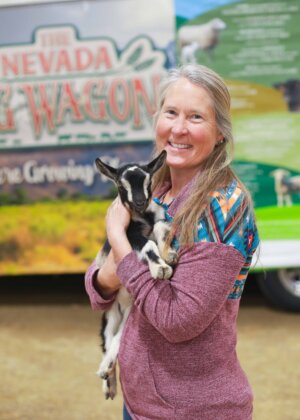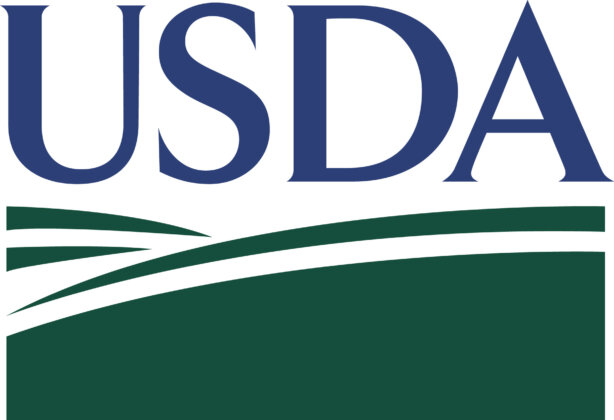Urban Ag Tour
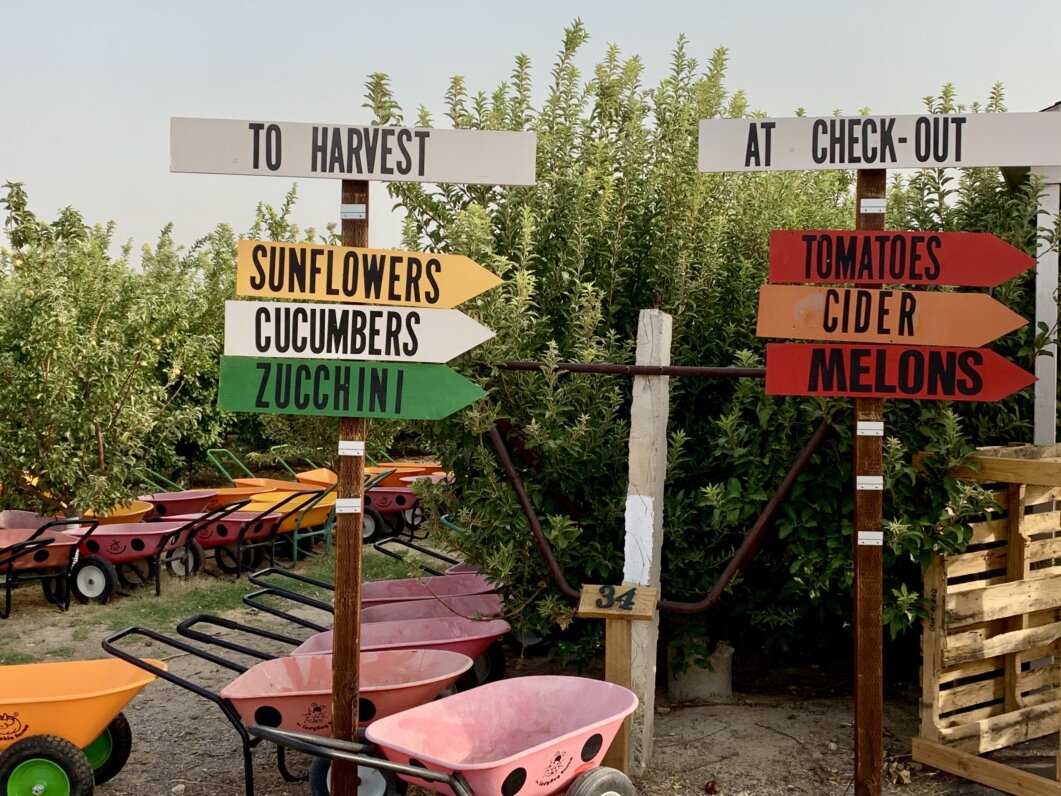
When people think of agriculture and farming, the sweltering 100 degree plus temperatures, bustling city streets and the glittering lights of the Las Vegas Valley aren’t what most people picture. Even in the Las Vegas Valley the Nevada Ag license plate slogan of “People Grow Things Here” rings true. Being in Las Vegas on a late summer day would make anyone skeptical that anything could grow here. Yet, there are dozens of agricultural operations underway around the Vegas Valley growing things that many would think impossible, from juicy tomatoes, zucchini, pomegranates, grapefruit, lemons, almonds, sweet potatoes and even mushrooms.
Perhaps the most well-known produce farm in the valley, is Gilcrease Orchard located on the corner of Whispering Sands Dr. and N. Tenaya Way. The origins of the orchard can be traced back a hundred years ago to 1920 when Elda and Leonard Gilcrease and their two sons John Theodore and William Orr purchased 900 acres in the Las Vegas Valley which included the Lower Tule Artesian Springs. The early years were a struggle for the family and the troubles only compounded as a result of the Stock Market Crash in 1929. Eventually Leonard had his fill of farming and returned to California. He and Elda divorced, and she carried on running the farm with her two sons.
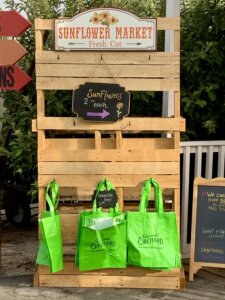 In the 1970’s Ted and Bill decided to stop producing alfalfa and focus their time and efforts on an orchard for the community. Bill began experimenting with apples to see which were suitable for the Vegas’s desert climate. Over the years the orchard grew to include pears, peaches, pomegranates and other fruits and vegetables. Now the orchard encompasses sixty acres of the valleys most fertile soil. Since its inception the orchard has been a “pick and pay” In 1997 the Gilcrease Foundation was formed as a way to preserve the way of life the two brothers experienced growing up. They also believed it was important for people to see where their food comes from to be able to pick a fruit and see, smell and taste the difference. Today thanks to Bill and Ted, thousands of visitors annually are able to appreciate the beauty and bounty of the earth firsthand and in person.
In the 1970’s Ted and Bill decided to stop producing alfalfa and focus their time and efforts on an orchard for the community. Bill began experimenting with apples to see which were suitable for the Vegas’s desert climate. Over the years the orchard grew to include pears, peaches, pomegranates and other fruits and vegetables. Now the orchard encompasses sixty acres of the valleys most fertile soil. Since its inception the orchard has been a “pick and pay” In 1997 the Gilcrease Foundation was formed as a way to preserve the way of life the two brothers experienced growing up. They also believed it was important for people to see where their food comes from to be able to pick a fruit and see, smell and taste the difference. Today thanks to Bill and Ted, thousands of visitors annually are able to appreciate the beauty and bounty of the earth firsthand and in person.
2020 has been a challenging year for agriculture, and it has left a lot of producers scrambling to find alternate markets for crops. The produce side of their operation hasn’t been negatively affected, if anything business has improved. “We are seeing more and more people come, just to get out of the house,” said Gilcrease Director Mark Ruben. There was also an uptick in demand due to supply chain shortages in supermarkets. Still though the Gilcrease Orchard hasn’t been without challenges, and still could face a few obstacles in the future.
One of the main pillars of the Gilcrease Foundations mission is to promote agriculture education. This year that has almost been impossible, and it is difficult to predict when they can resume those efforts. A normal year at Gilcrease would have taken 12,000 Las Vegas children on a tour of the orchard. Covid-19 restrictions closed down Clark County Schools back in March and schools remained closed and are using distance learning. The trip to the orchard was always a great experience and a crowd pleaser. Once at the orchard they would get to take a wagon ride around the orchard get to look at the tortoise and owl habitat as well as a working display beehive, and to finish it off they would get to pick one thing that was in season.
The busiest month for the Orchard is October. People love to come see the pumpkin patch and get to pick their own pumpkin so much, so they usually sell out. Others come to quench their thirst with their famous cider juiced right there on the property. The orchard produces 15,000-gallon equivalents of cider every year. If you have a real sweet tooth and Halloween candy isn’t your thing, they have apple cider donuts that have developed their own fan base entirely. Mark acknowledges that October is the popular month, but he wants people to know they do grow other stuff besides ornamental pumpkins, and they should come buy fresh fruits and vegetables throughout the year. The fall festivities this year begin on September 26th through October 31st there will be no wagon rides and attendance will be limited due to social distancing requirements.
When asked about the challenges of urban farming in the desert, the biggest issue he notes is that it is difficult to keep things from burning in the sun, and the sun can prevent some things from turning that ripe color that associated with certain fruits, like apples often won’t turn that deep red people expect. Another challenge and opportunity the orchard has can be educating the public. Since the orchard is u-pick, people often will go pick produce that isn’t ready and it will often go to waste. To combat this Gilcrease has developed an app that lets customers know what areas of the orchard are ready for harvest.
After doing this for over 10 years, Director Mark Ruben says he’s always surprised by how surprised people are when they see what goes on at Gilcrease Orchard, and how amazed they are a place like it exists in the Las Vegas Valley, and that things actually do grow here. Some words of wisdom he has for people looking to garden in Las Vegas is that it is possible, but remember these three things; do your research, get the right sun exposure, get your timing right, both for your location and the type of plant.
Garden Farms
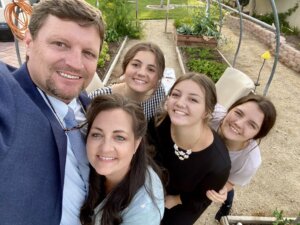 While conventional agriculture typically relies on a large contiguous plot of land, that isn’t the case with Garden Farms. What separates Garden Farms from other operations, is they’ve managed to take small pieces of property, all across the valley and turn them all into productive gardens, that yield a wide variety of crops like strawberries, okra, almonds, and even elusive citrus fruits like lemons, limes and grapefruits.
While conventional agriculture typically relies on a large contiguous plot of land, that isn’t the case with Garden Farms. What separates Garden Farms from other operations, is they’ve managed to take small pieces of property, all across the valley and turn them all into productive gardens, that yield a wide variety of crops like strawberries, okra, almonds, and even elusive citrus fruits like lemons, limes and grapefruits.
Garden Farms was born in crazy year just like the year 2020 has been. Bryan Vellinga and his wife Brittany started Garden Farms back in 2010 in the middle of the Great Recession. The Great Recession served as an awakening for a lot of people to plan for the future and to be more self-sufficient especially in a time when the future was uncertain and the economy in turmoil. Bryan and Brittany had a garden and a successful one at that, and they began to wonder if people would pay to have a garden installed. Turns out others had interest and now Garden Farms has grown to manage dozens of private gardens around the valley. In addition to their private garden clients pre-Covid-19 they boasted management upwards of 170 school gardens in the Clark County School District. Due to school closures and budget cuts, that number has leveled off a bit to around 150. They also manage several community gardens, and are working with municipalities to plan more.
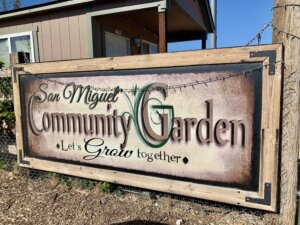 One of the properties Garden Farms manages is the San Miguel Community Garden, a 2-acre parcel adjacent to El Jen Senior Living. El Jen has graciously allowed the use of the ground, so it can be utilized as a community garden. According to Bryan it’s a mutually beneficial relationship, the ground gets utilized and producing, not only that it beautifies the land and makes the senior home more enjoyable. “We put in a bridge so they can come over it always makes me happy to see the wheelchair marks because it means they’ve been out here putting around enjoying it,” said Bryan.
One of the properties Garden Farms manages is the San Miguel Community Garden, a 2-acre parcel adjacent to El Jen Senior Living. El Jen has graciously allowed the use of the ground, so it can be utilized as a community garden. According to Bryan it’s a mutually beneficial relationship, the ground gets utilized and producing, not only that it beautifies the land and makes the senior home more enjoyable. “We put in a bridge so they can come over it always makes me happy to see the wheelchair marks because it means they’ve been out here putting around enjoying it,” said Bryan.
When you walk through the gate, you may have doubts you are still in Southern Nevada. If all you had to go off was the plants you would be confused. Towards the center of the garden you’d be looking at a tall green patch of okra and not far from there are about five different types of peppers, including the infamous Carolina Reaper. The peppers and okra leave you feeling like you’re in Louisiana. On the other end you might think you stepped into Southern California because you’d be standing in small grove of trees, apples, pears and almonds. Then there’s things like lemons, grapefruit and limes, that are supposed to be impossible to grow in southern Nevada. A walk in San Miguel is definitely an eye-opening experience that will broaden your horizons.
From its inception Garden Farms has always been a proponent of agricultural education. They believed that for a lot of people the only thing that kept them from gardening was a lack of knowledge brought on by people being so far removed from where their food comes from. This lack of knowledge first of all keeps people from even trying and secondly even when people do, they will often fail and never try again. Afterall it’s disheartening to buy and plant four tomato plants and watch them die so much so you might not try again. This is why Garden Farms is so successful they offer their knowledge and expertise to get people up and running. Bryan acknowledges this is a terrible business model because typically you’d want to retain customers. For him though his company is about empowering people and teaching them that they have a right and a responsibility to learn how to grow food for themselves.
To further accomplish their educational mission, in 2017 the Garden Farms Foundation was formed. Through the foundation, schools are assisted with finding grants and getting a garden installed. In addition to that Garden Farms also develops educational curriculum, and educational videos for teachers and students. Gardeners are able to go into school and do workshops. One aspect that makes them so unique, is there holistic approach. Where other programs might only focus on how to plant, Bryan sees that a garden is able to teach multiple subjects. One example he gave is in math, rather than figuring out the volume of a cube from a picture in a math book. Students are able to go out in the garden and measure the length, width and height of a planter box and figure out how many cubic feet of soil are needed. He envisions science teachers using it to be able to teach biology and concepts like photosynthesis. He’s even seen English teachers bring students just to sit and write in the garden, which produces better results. Business classes and school even utilize gardening to practice running a business and hosting school farmers markets to raise money. Bryan believes it’s a more practical form of education and students retain the information better.
Recently Garden Farms has expanded to include an online farmers market. For many small producers selling at a traditional farmers markets aren’t the right fit for them. They can be time consuming, have high fees and lots of competition from trucked in produce. People may not have enough of a surplus to sell to begin with to justify the overhead of a farmer market. To Bryan the purpose of a farmer’s market is to buy fresh produce, but it seems like farmers markets have become events rather than outlets. The idea was to streamline and get rid of the craft fair element. Make it truly local and make it all about being able to buy high quality local produce.
To be on the site you have to be a local producer and obtain a producer’s certificate from the Nevada Department of Agriculture. A producer is able to go in weekly and list what they have available and what the price is. Consumers are then able to go in and buy from multiple growers then every week orders are compiled and delivered. Garden Farms then charges a delivery fee as well as a slight markup. This benefits producers because it eliminates the need to actually sit at a farmers’ market and the fees associated with that. It also favors local producers and minimizes waste.
When asked about the challenges of urban farming, Bryan said the biggest challenge is educating the public and teaching them that they have the right and the ability to do this. Some other issues they face are just being able to acquire the land and resources. Zoning and HOAs do present some restrictions, as well. HOA’s often have bands on fruit trees and gardens, and you have to have the right type of zoning to do something a little larger. As far as the heat goes, he finds people often overshade trying to account for the heat and that hinders production.
As far as Covid-19 is concerned it has negatively impacted the educational aspect. Schools have faced budget cuts for these types of programs. Overall most schools have been able to keep their gardens and they are still being maintained. In an effort to adapt Garden Farms Foundation has been able to produce online educational materials and videos that are being utilized right now. Covid-19 has had some positive impacts as well more people have become interested in gardening and becoming more self-sufficient. Overall Covid-19 has been good for urban agriculture.
“I am in no way against big farms even though some might guess I am,” said Bryan. “If anything, what we do supports larger farms we need big farms, because people are so removed from their food it’s easy for big ag to get vilified. So, an urban farm is critical, it shows people just how much effort is needed to grow even just small amounts of food, and then they start to realize big ag is needed”
Although urban farming presents challenges its full of benefits. “It beautifies your surroundings; its good therapy and it doesn’t get any fresher than out of your own backyard” said Bryan. Some pieces of advice he would give to people wanting to garden are first- Location, Location, Location, make sure you plant in the right soil and in a spot with good sun. Second, get a good irrigation system in place that’s efficient for what your watering. Third, plant in the right time of year. Fourth, plant the right plant, make sure you get the right variety for your climate and the season.
He also wants to make it clear that this has been a team effort with his wife Brittany and his family and that Garden Farms wouldn’t be what is today without her and them. Despite all the success and interest, they’ve generated, they believe that they’ve only scratched the surface of what is possible, and they are excited for what the future holds.
Cluck It Farms
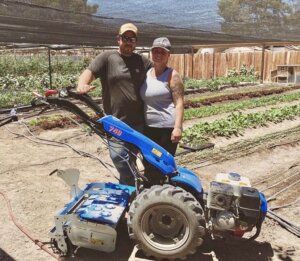 With names there’s always a reason, explanation and or a story. For Amanda and Duke Christiansen, “cluck it” became their motto, because it’s the family friendly version and farm version of the rhyming phrase often invoked when things go unexpected wrong and bad. In agriculture, things often do go wrong and unexpected, and things get difficult and frustrating, and sometimes all you can do is stop and think “cluck it”. It’s doubly applicable since they are also an egg farm.
With names there’s always a reason, explanation and or a story. For Amanda and Duke Christiansen, “cluck it” became their motto, because it’s the family friendly version and farm version of the rhyming phrase often invoked when things go unexpected wrong and bad. In agriculture, things often do go wrong and unexpected, and things get difficult and frustrating, and sometimes all you can do is stop and think “cluck it”. It’s doubly applicable since they are also an egg farm.
Cluck It Farms began in 2017 when Amanda began experimenting by growing different crops on her property. After experimenting she discovered the best way to irrigate was with drip tape, because it was more efficient and gets water to the roots more efficiently. The other benefit is that watering on the surface can create a crust, that makes it difficult for subsequent watering. Another lesson they learned was that because they were doing this on such a small scale was to employ regenerative agriculture and quick to mature crops. Rather than relying on sheer volume to produce revenue they found they needed to grow things that could be harvested continually every week. So, they grow a lot of types of leafy greens and things like squash and miniature cabbages that have a quick turnaround as well as peppers that continually produce throughout the season. Since greens are so delicate, they grow them under cover and have to harvest early in the morning. In order for it to be profitable they have to be careful and excellent at planning ahead.
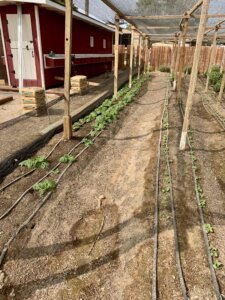 Originally, the approach was to take her produce to farmers markets. The weather proved difficult it didn’t take long for greens to wilt in the heat of summer and it resulted in waste. She found it was difficult to compete with larger operations trucking produce in and it was a huge time commitment and it wasn’t very predictable. After that she then did a farm stand where people could come and purchase directly from her. This too resulted in some waste. Eventually she came up with the idea to start a CSA.
Originally, the approach was to take her produce to farmers markets. The weather proved difficult it didn’t take long for greens to wilt in the heat of summer and it resulted in waste. She found it was difficult to compete with larger operations trucking produce in and it was a huge time commitment and it wasn’t very predictable. After that she then did a farm stand where people could come and purchase directly from her. This too resulted in some waste. Eventually she came up with the idea to start a CSA.
Community Supported Agriculture and CSAs are growing in popularity across the country. The way they work is a farmer will sell “shares” to consumers and in exchange they get a percentage of the yield for the season. Usually this translates into a produce box about once a week throughout the season. The idea is simple enough, but the benefits are immense. For the farmer the benefit is they get revenue upfront, seed money for actual seeds and other supplies they need. It also gives them a chance to market before the busy growing season. For the consumer they get fresh produce and they usually get to see the farm.
Amanda and Duke both agree that another benefit is having a personal relationship between growers and consumers. For example, “it cuts down on waste” she says “because you go to a supermarket and buy a bag of lettuce if you don’t get around to using it you just throw in in the trash. When you know the person, who grew it and you know how much time and effort they put in to grow it, you wouldn’t dare waste it”. Because of that relationship CSA members will often email her about how to use a specific ingredient. At times though being so accessible has its challenges and some customers can be difficult to deal with.
“People get used to that perfect produce in the grocery store and they think that’s how it all looks. they don’t realize that a lot of that stuff has been treated to look perfect,” said Amanda “The stuff in the store isn’t organic it isn’t as fresh but sometimes it looks more appealing.”
So, they get some complaints here and there but by and large people are happy. People love the idea and the personal relationship, so much so there CSA has grown from 50 to 190.
To be more efficient Cluck It farms utilizes a CSA management platform called Harvie. A program developed by Simon Huntley. Huntley grew up on small farm before obtaining a degree in Information Sciences and Technology. He combined his background in agriculture and his skills in IT and formed Small Farm Central which morphed into Harvie. Through Harvie farmers are able to plan what crops to plant and when to keep up with weekly demand. Consumers are able to rank preferences so they get a produce share that’s right for them. Harvie also assists with sales and marketing. Cluck It Farms utilizes the survey function to create custom produce bags and for a small delivery fee.
While the CSA is the bulk of their business the do still run a farm stand to sell some of the extras. In addition, they produce about 80 dozen eggs a week that are an add on purchase only available to CSA members. They like everyone else struggle on what to do with zucchini so when they have extra of that they make and sell zucchini bread. Another aspect of the business, and probably why they are so popular is their Farm to Table dinners they host once a month. Once Covid-19 restrictions end they hope to resume those. Their Farm to Table dinners were ticketed events where ingredients from their garden are featured throughout multiple courses and all this takes place not 20 yards from where the produce was grown. It’s an eye-opening experience and everyone enjoys it.
When asked about some of the challenges they face, like any proud farmer would they initially brushed it off.“Well you never do get used to the heat here, it sucks, you just try to beat it by going out early,” said Amanda. “Weeding always stinks, you just got to stay on them and get them when they are small.”
Some of the other challenges are the small space, they don’t have a lot of room to experiment like they could on a larger property. But on the flip side Amanda notes, “its economical, we live here we pay the mortgage, so it beats having to go buy more property. Plus, we are close to our consumers and there isn’t a lot of competition. The soil also wasn’t that great when we started, but overtime they’ve made it good soil.”
Covid-19 also created some unique challenges for a while there was a run on gardening supplies and seed, because everyone was preparing for mass famine a lot of things were on backorder, but eventually suppliers got it under control. Covid-19 also brought them more members after the panic wore off some did leave but a lot of stayed.
Some advice Amanda and Duke have for those wishing to start a garden is understand you live in Las Vegas. One of the things that frustrates them the most is when people ask for help and they say, “but back, in Michigan or whatever state we did it like this.” “you aren’t there, you’re here,” is Amanda’s reply. The point being is you have to adjust what you grow and when you plant it. For example, you plant tomatoes in May here, they’re toast, but you maybe could do that in Colorado and be fine. Some other advice is to test your soils, and make adjustments, don’t just assume because you have bad soil you can’t grow anything. If you work at it and use manure and compost and alternate crops you can build it up and make it good soil.
It’s exiting, to see the amount of agriculture going on in the Las Vegas Valley, like at Gilcrease Orchard, where they strive to preserve the history and legacy of Bill and Ted Gilcrease, and the traditions of an older Las Vegas for future generations. The work at Garden Farms is also exiting to see, as they strive to make everyone successful at starting their own garden and provide an alternative outlet for producers. It’s also impressive to see how successful Cluck It Farms and their CSA has been. It’s great to step back and see just how far urban ag has gone in Las Vegas, but it’s like Bryan Vellinga says “it’s only just beginning”.
Related Articles
Become a Member
